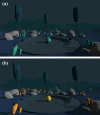Development and Pilot Test of a Virtual Reality Respiratory Biofeedback Approach
- PMID: 32361963
- PMCID: PMC7391394
- DOI: 10.1007/s10484-020-09468-x
Development and Pilot Test of a Virtual Reality Respiratory Biofeedback Approach
Abstract
Breathing exercises with biofeedback have benefits over breathing exercises without biofeedback. However, the traditional measurement of respiratory signals that is required as part of feeding back the breath incurs high cost and effort. We propose a novel virtual reality (VR) based approach to respiratory biofeedback that utilizes the positionally tracked hand controllers integrated into modern VR systems to capture and feedback the respiration-induced abdominal movements. In a randomized controlled laboratory study, we investigated the feasibility and efficacy of the developed biofeedback algorithm. In total, 72 participants performed a short breathing exercise in VR with or without respiratory biofeedback. The feedback integration resulted in a satisfactory user experience, a heightened breath awareness, a greater focus on slow diaphragmatic breathing and an increased respiratory sinus arrhythmia. This evidences that the novel biofeedback approach is low-cost, unobtrusive, usable and effective in increasing breath awareness and promoting slow diaphragmatic breathing in the context of VR-based breathing exercises. Future studies need to investigate the broader applicability and long-term effects.
Keywords: Abdominal breathing; Biofeedback; Diaphragmatic breathing; Respiratory biofeedback; Respiratory sinus arrhythmia; Virtual reality.
Conflict of interest statement
The authors declare that they have no conflict of interest.
Figures







Similar articles
-
Using a virtual reality game to train biofeedback-based regulation under stress conditions.Psychophysiology. 2025 Jan;62(1):e14705. doi: 10.1111/psyp.14705. Epub 2024 Oct 9. Psychophysiology. 2025. PMID: 39385361 Free PMC article.
-
Development of a modular stress management platform (Performance Edge VR) and a pilot efficacy trial of a bio-feedback enhanced training module for controlled breathing.PLoS One. 2021 Feb 2;16(2):e0245068. doi: 10.1371/journal.pone.0245068. eCollection 2021. PLoS One. 2021. PMID: 33529187 Free PMC article.
-
Slow Breathing Exercise with Multimodal Virtual Reality: A Feasibility Study.Sensors (Basel). 2021 Aug 13;21(16):5462. doi: 10.3390/s21165462. Sensors (Basel). 2021. PMID: 34450909 Free PMC article.
-
Evaluation of Heart Rate Variability and Application of Heart Rate Variability Biofeedback: Toward Further Research on Slow-Paced Abdominal Breathing in Zen Meditation.Appl Psychophysiol Biofeedback. 2022 Dec;47(4):345-356. doi: 10.1007/s10484-022-09546-2. Epub 2022 May 17. Appl Psychophysiol Biofeedback. 2022. PMID: 35579767 Review.
-
Virtual reality biofeedback interventions for treating anxiety : A systematic review, meta-analysis and future perspective.Wien Klin Wochenschr. 2022 Jan;134(Suppl 1):49-59. doi: 10.1007/s00508-021-01991-z. Epub 2022 Jan 6. Wien Klin Wochenschr. 2022. PMID: 34989862 Free PMC article.
Cited by
-
Existing Meditation and Breathing Devices for Stress Reduction and Their Incorporated Stimuli: A Systematic Literature Review and Competition Analysis.Mayo Clin Proc Digit Health. 2023 Aug 8;1(3):395-405. doi: 10.1016/j.mcpdig.2023.06.008. eCollection 2023 Sep. Mayo Clin Proc Digit Health. 2023. PMID: 40206629 Free PMC article. Review.
-
Immersive Virtual Reality Influences Physiologic Responses to Submaximal Exercise: A Randomized, Crossover Trial.Front Physiol. 2021 Sep 30;12:702266. doi: 10.3389/fphys.2021.702266. eCollection 2021. Front Physiol. 2021. PMID: 34658904 Free PMC article.
-
Using a virtual reality game to train biofeedback-based regulation under stress conditions.Psychophysiology. 2025 Jan;62(1):e14705. doi: 10.1111/psyp.14705. Epub 2024 Oct 9. Psychophysiology. 2025. PMID: 39385361 Free PMC article.
-
Probing corporeal awareness in women through virtual reality induction of embreathment illusion.Sci Rep. 2024 Apr 23;14(1):9302. doi: 10.1038/s41598-024-59766-1. Sci Rep. 2024. PMID: 38654060 Free PMC article.
-
Effectiveness of Virtual Reality-Complemented Pulmonary Rehabilitation on Lung Function, Exercise Capacity, Dyspnea, and Health Status in Chronic Obstructive Pulmonary Disease: Systematic Review and Meta-Analysis.J Med Internet Res. 2025 Apr 7;27:e64742. doi: 10.2196/64742. J Med Internet Res. 2025. PMID: 40193185 Free PMC article.
References
-
- American Psychological Association. (2018). Stress in America: Generation Z. Stress in America™ Survey. Retrieved from https://www.apa.org/news/press/releases/stress/2018/stress-gen-z.pdf.
-
- Bhandari, R., Parnandi, A., Shipp, E., Ahmed, B., & Gutierrez-Osuna, R. (2015, May). Music-based respiratory biofeedback in visually-demanding tasks. In Proceedings of the International Conference on New Interfaces for Musical Expression (pp. 78–82). Los Angeles, CA: Baton Rouge.
-
- Burg JM, Michalak J. The healthy quality of mindful breathing: Associations with rumination and depression. Cognitive Therapy and Research. 2011;35:179–185. doi: 10.1007/s10608-010-9343-x. - DOI
Publication types
MeSH terms
LinkOut - more resources
Full Text Sources

